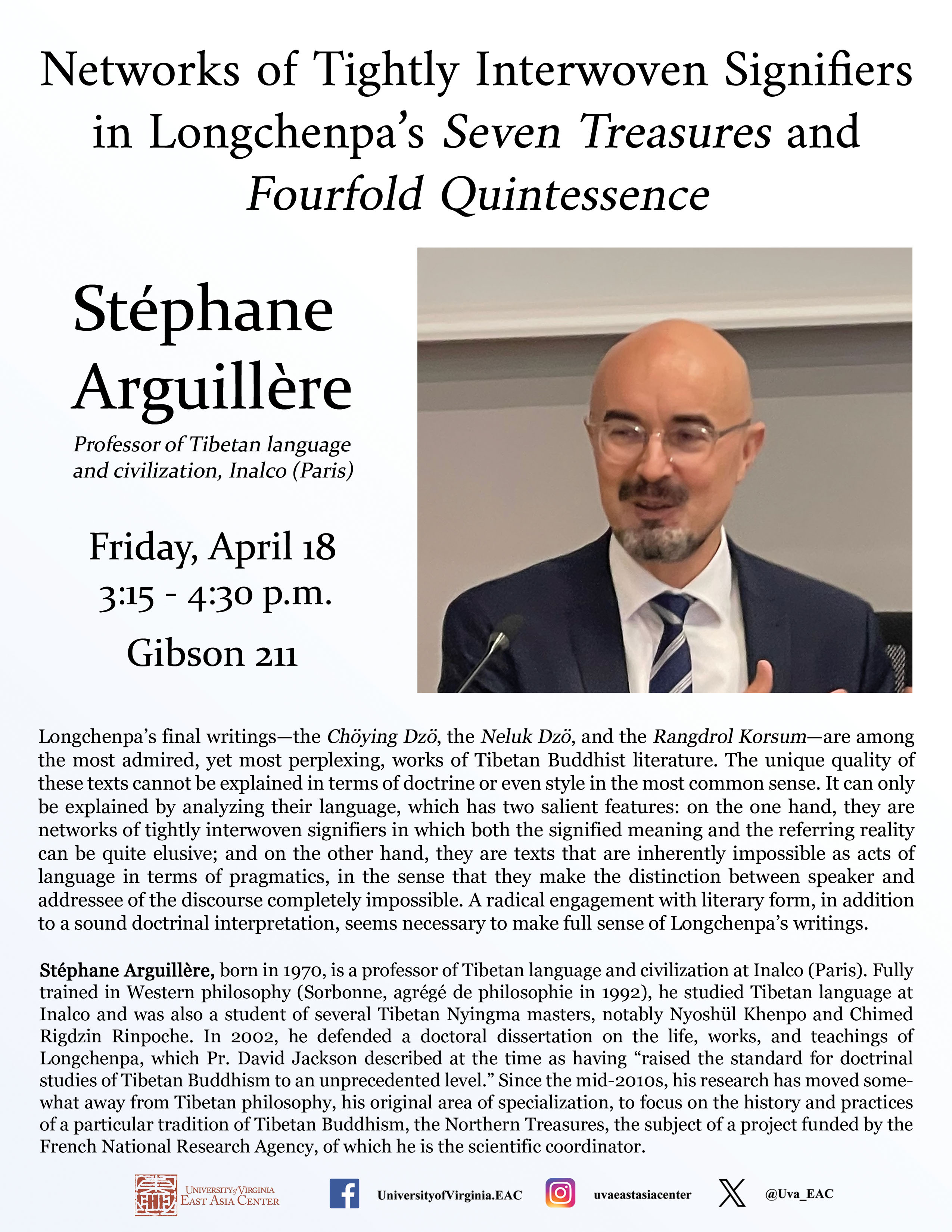Networks of Tightly Interwoven Signifiers in Longchenpa's Seven Treasures and Fourfold Quintessence
Audio recording:
The East Asia Center is excited to welcome Stéphane Arguillère, Professor of Tibetan language and civilization at Inalco (Paris) for a speaker series lecture "Networks of Tightly Interwoven Signifiers in Longchenpa's Seven Treasures and Fourfold Quintessence."

Longchenpa (Klong chen rab 'byams, Tibet, 1308-1364) is generally regarded as the most important author on Dzogchen in the Nyingma tradition. Part of his outstanding reputation is due to the quality of the content of his works as magistral syntheses and clarifications of earlier literature, both in theory (in the Seven Treasures) and in practice (in the Fourfold Quintessence). However, Tibetan specialists in this tradition especially admire some of his writings as supreme expressions of Dzogchen (especially the Chos dbyings rin po che’i mdzod and its commentary). These are most likely Longchenpa’s last writings and contain some unique doctrinal clarifications. In fact, however, it is their form, their language, that makes them so unique and causes the admiration of Tibetan specialists. This language is poetic, but not in the standard Tibetan way: the poetical effect arises from a systematic use of the special technical terminology of Dzogchen in a form surely inspired by Dzogchen tantras and by “songs of realization,” although strangely combined with a quasi-scholastic commentary. More specifically, these terms are reflected in each other rather than explained by common Buddhist terminology. These texts could thus be formally described as networks of tightly interwoven signifiers, in which it can be difficult to point out in a non-tautological way the signified meaning, or the referred reality (which is supposed to be self-evident to those who have been introduced to it, and completely obscure to others). But things get even more interesting when one tries to interpret them in terms of pragmatics applied to literary analysis: If at some point we really have an author addressing his readers, the discourse quickly moves into a self-description of the ultimate nature, in terms that preclude the possibility of a distinction between a speaker (the equivalent in lyric poetry of what the narrator would be in a novel) and an addressee (which, incidentally, suggests that the one to whom a literary discourse is addressed, the intended audience as projected by the text itself, may be as different from the reader as the narrator is from the author of a novel). This attention to literary form, which paradoxically was first inspired by reading Lacan's seminar on psychosis and his formal analysis of psychotic discourse, seems necessary to make full sense of Longchenpa's writings in complement to a solid doctrinal interpretation.
Fully trained in Western philosophy (Sorbonne, agrégé de philosophie in 1992), Professor Arguillère studied Tibetan language at Inalco and was also a student of several Tibetan Nyingma masters, notably Nyoshül Khenpo and Chimed Rigdzin Rinpoche. In 2002, he defended a doctoral dissertation on the life, works, and teachings of Longchenpa, which Prof. David Jackson described at the time as having “raised the standard for doctrinal studies of Tibetan Buddhism to an unprecedented level.” Since the mid-2010s, his research has moved somewhat away from Tibetan philosophy, his original area of specialization, to focus on the history and practices of a particular tradition of Tibetan Buddhism, the Northern Treasures, the subject of a project funded by the French National Research Agency, of which he is the scientific coordinator.
The talk will be held Friday, April 18, from 3:15 - 4:30 p.m. in Gibson 211.